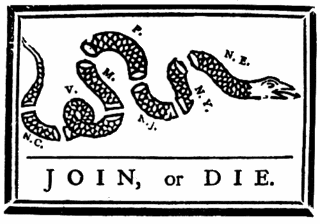 This post is a little different from our traditional material here at AC but since things have been a little slow I decided to go ahead and publish it here.
This post is a little different from our traditional material here at AC but since things have been a little slow I decided to go ahead and publish it here.In 1754, Philadelphia printer Benjamin Franklin became one of the earliest political cartoonists in American history. As a printer, Franklin had regularly published political commentaries on various issues. His "Join or Die" publication, however, was uniquely different and would be remembered for generations to come.
During the early part of 1754, Franklin became gravely concerned about the security and future of the British colonies. As war between Britain and France loomed on the horizon, Franklin believed that colonial unity was becoming increasingly important. In Franklin's mind, each individual colony was going too far in its own direction, and thus neglecting the greater needs of the American colonies as a whole. As a result, Franklin created his "Join or Die" cartoon to serve as an appeal for unity. The cartoon (originally done as a wood carving) was posted not only in Franklin's paper, but was distributed across the colonies. The snake (each section representing an individual British colony), was purposely cut into pieces, suggesting that death would come not only to the snake, but to the colonies as well if they chose to stay divided. (It is also worth noting that 18th century society believed that a snake would come back to life if its pieces were all put together and buried before sundown).
During the French and Indian War, Franklin's "Join or Die" slogan was used as a battle cry, inspiring colonies to unite against the French. In the years prior to the American Revolution, Franklin would again use his "Join or Die" logo to promote union with the British (Franklin even suggested to Parliament that the colonies could be joined with Great Britain in the original Acts of Union, which had united Scotland and England). England's passage of the Stamp Act in 1765 gave Americans a cause to rally around. Naturally, Franklin's slogan was brought out of the closet, this time to rally against the British.
With the onset of the American Revolution, patriots from across the colonies used Franklin's "Join or Die" cartoon to promote the cause of independence. The slogan could regularly be seen in the windows of shops, on flags, and in newspapers.
Years later, Northerners would again resurrect Franklin's political cartoon to promote the cause of unity in the early years of the Civil War. There are even more recent instances of "Join or Die" being used to promote a political cause. During the 2000 presidential election, Republicans raised the banner of "Join or Die" to promote unity in the party. After President Obama's election, the "Join or Die" slogan (and the rattlesnake slogan in general) became a favorite for the Tea Party.
But why the fascination with rattlesnakes?
Early American society had a strange interest in the rattlesnake, so much that it was even considered a candidate (along with the turkey) for the national symbol of the United States. Americans loved the rattlesnake for several reasons:
1.) It was believed that the rattlesnake was indigenous to only North America.
2.) The rattlesnake has no eyelids and is therefore always vigilant.
3.) It was believed by colonists that the rattlesnake never picked a fight but also never retreated once attacked.
4.) Colonists believed that a den of rattlesnakes maintained more unity amongst its members than any other specie of animal life.
But like "E Pluribus Unum" and other early American beliefs, the rattlesnake went the way of the Dodo Bird. Much to the relief of many early American Christians, who saw the rattlesnake in the same light as the evil serpent from the Garden of Eden, the mighty American eagle soared to the top of the list and eventually became America's official symbol (much to the dismay of Benjamin Franklin, who called the eagle "a ravenous vulture of the sky."). Despite its fall from grace, the rattlesnake still maintains a popular place in American culture.
Tomorrow's post: The Gadsden "Don't Tread on Me" Flag.
2 comments:
Interesting about the rattlesnake - I'd never heard that.
But,
"...like "E Pluribus Unum" and other early American beliefs, the rattlesnake went the way of the Dodo Bird,"
to the best of my knowledge, E Pluribus Unum is still on the Great Seal of the United States. But then I was away for the weekend.
Upon reading my comment, I thought it sounded a little snotty. So I'm adding a belated :)
Post a Comment